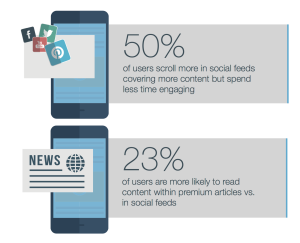Programmatic Investment on the Rise; Advertising on Premium Editorial Websites More Effective
by Sonja Kroll on 23rd Jun 2016 in News


ExchangeWire Research’s weekly roundup brings you up-to-date research findings from around the world, with additional insight provided by Rebecca Muir, head of research and analysis, ExchangeWire. In this week’s edition: Programmatic investment on the rise; Impact of content environment on advertising; and Smartphones surpass PCs as most prevalent household device.
Programmatic stakeholders keen on in-house solutions
In a study among more than 1,000 advertisers, agencies, and publishers from 29 markets, the IAB Europe surveys current adoption of programmatic and stakeholder perspectives on programmatic’s potential for strategic competitive advantage. The results are encouraging: over 90% of the respondents replied that they will increase programmatic investment or revenue over the next 12 months; 40% of the study participants expect an increase of more than a third.
The majority of stakeholders interviewed for the study are already engaging in some form of programmatic advertising (87% of advertisers, 92% of publishers, and 93% of media agencies).
However, with regards to in-house solutions, advertisers are the stakeholder group least likely to have programmatic in-house at this point in time; while agencies see themselves at the forefront of programmatic adoption, gaining trading, operational, and audience targeting benefits. Publishers are still approaching programmatic cautiously, mainly interested in managing their own data and maximising their revenues through effective, autonomous inventory monetisation.
Only 13% of advertisers, 8% of publishers and 7% of media agencies responded that they are not using programmatic technology at all.
Advertising on premium editorial websites more effective
Teads measures and compares the impact of content environment on the audience – and, therefore, the performance of mobile advertising displayed therein. The findings: users on websites that contain premium publisher content are more engaged and attentive.
The study followed a two-pronged approach: using eye-tracking technology, Teads tracked the content consumption behaviour of the participant and their interaction with advertising. In an interview with participants, the effectiveness of advertising was then measured.
 According to the study, users scroll less and read more on premium publisher sites than on social media: 23% of users are more likely to read content within premium articles than in social feeds. Video ads are more successful within premium content environments, too: nearly nine out of ten users view ads within premium in-article settings, compared to six out of ten on Social Media. Users look 24% longer at in-article video ads, versus video advertising appearing in social feeds.
According to the study, users scroll less and read more on premium publisher sites than on social media: 23% of users are more likely to read content within premium articles than in social feeds. Video ads are more successful within premium content environments, too: nearly nine out of ten users view ads within premium in-article settings, compared to six out of ten on Social Media. Users look 24% longer at in-article video ads, versus video advertising appearing in social feeds.
"With the rise of mobile, there are an endless number of content environments for marketers to reach their target audiences in, which inevitably calls into question which ones are the most effective in engaging consumers", comments Bertrand Quesada, CEO, Teads. "This study proves that premium editorial websites are the most effective place for brands to advertise and promises a more relaxed, engaged user who is guaranteed to have more focus and attention on the advertising."
Quesada’s interpretation is also backed up by the study finding that longer reading time leads to increased engagement: 80% of consumers’ engagement with publisher sites is spent reading, versus 65% on social feeds. Users are 23% more likely to read content within premium articles versus in social feeds.
The study was conducted with 115 participants who were exposed to multiple video ads on a number of mobile websites on their smartphones.
Smartphones are the most prevalent household device
YuMe takes a look at the multi-screen RT behaviour of digital video consumer in order to draw conclusions for strategic reaching and influencing the audience of advertising. The results have just been published in their study 'Video: Day in the Life & Platform Pathway'.
According to YuMe, the bulk of video sessions is generated by a small number of users: 10% of users generate 60% of long-form, and 43% percent of short-form, video sessions.
When it comes to most-used devices, smartphones rule the roost: smartphones have surpassed PCs as the most prevalent household device. Comparing growth rates of the various devices, streaming media players record the biggest increase among all video device types in 2015. Tablets, on the other hand, have the highest reach among monthly video streamers.
Connected home entertainment devices, such as smart TVs, streaming media players, and game consoles, are not competing against traditional devices like PCs, smartphones and tablets, but complementing these primary online devices, the study finds. While smartphone and PC usage peaks throughout the day, consumers shift to entertainment in the evening on home entertainment devices.
"Modern digital consumers have become more complex with the adoption of new digital device types. Consumption of digital video is not a predictable exercise that occurs at specific times of day, on a specific device. As this real-life activity-tracking research demonstrates, video viewers’ habits are a function of many variables with digital connections happening around the clock across multiple screens", explains Hannu Verkasalo, CEO and Founder, Verto Analytics. "This research affirms, through real-life activity tracking, that brands and advertisers cannot ignore the need for a cross-platform video strategy."
After video, music streaming is the second-most accessed content on home entertainment devices.
AdvertiserAgencyCross-DeviceDisplayMobileProgrammaticPublisherSocial MediaTargetingVideo








Follow ExchangeWire